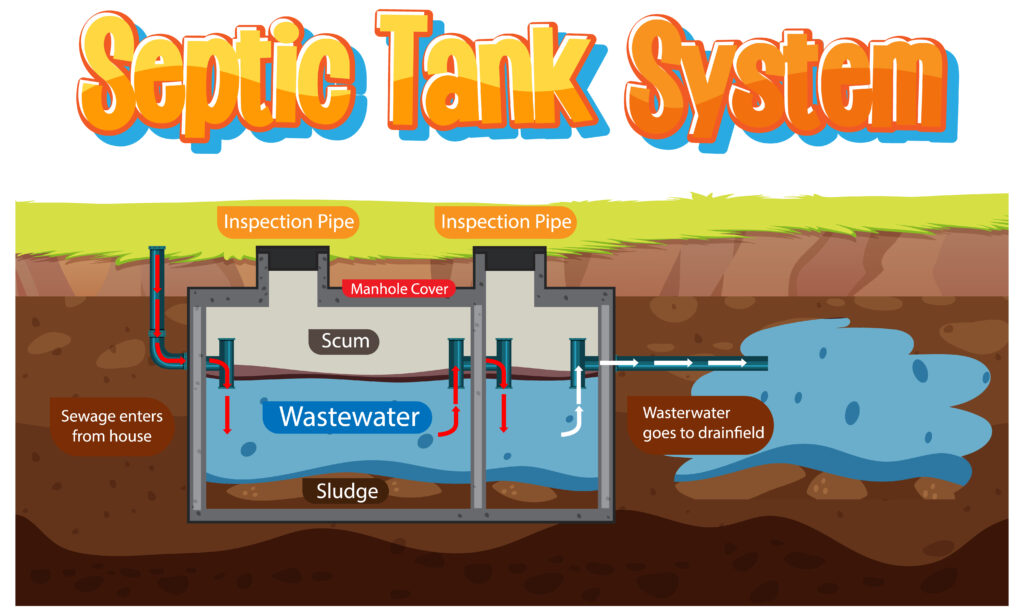Gas Leak: Why It Happens and What to Do
Gas leaks are a serious safety hazard that can lead to devastating consequences if not addressed promptly. From explosions and fires to health complications…

Septic tanks are a vital component of wastewater management systems, particularly in areas where municipal sewer systems are unavailable. These underground structures treat and dispose of household wastewater, ensuring environmental safety and public health. Septic systems are commonly used in rural areas or homes that are off the grid and not connected to centralized sewer networks.
A septic tank is a watertight container, typically made of concrete, fiberglass, or plastic, buried underground. It is designed to collect, treat, and manage wastewater from households. The tank separates solid waste, which settles at the bottom as sludge, from lighter substances like oil and grease that form scum on the surface. The treated liquid, known as effluent, flows out to a drain field where further natural filtration occurs.
Septic systems are essential wastewater treatment structures for homes and properties not connected to a municipal sewer system. These systems come in different designs, each customized to specific environmental conditions, soil types, water table levels, and usage patterns. Below is a detailed explanation of the most common types of septic systems.
A conventional septic system is the most traditional type, consisting of a septic tank and a drain field, sometimes called a leach field. Wastewater flows into the septic tank, where solids settle at the bottom, and oils float to the top. The liquid, known as effluent, moves from the tank to the drain field, where the soil naturally filters and treats it before it returns to the environment. This system works best in areas with soil that allows for proper filtration.
A chamber system is similar to a conventional system but replaces the traditional drain pipes in the drain field with interconnected plastic chambers. Effluent flows through these chambers and is absorbed into the surrounding soil. Chamber systems are easier to install in some areas and can handle varying levels of wastewater more effectively. They are a good option for homes with limited space or challenging installation conditions.
An aerobic treatment unit (ATU) takes a more advanced approach by introducing oxygen into the treatment process. The addition of oxygen allows bacteria to break down waste more efficiently and thoroughly. After treatment, the effluent is discharged into a drain field or directly into the environment if it meets safety standards. This system is particularly useful in areas with poor soil conditions or strict environmental regulations requiring higher levels of treatment.
A mound system is an alternative for locations where the soil cannot support a traditional drain field. Instead of relying on natural soil for filtration, a mound system uses an above-ground mound made of sand and gravel. Wastewater is pumped into the mound, where the sand filters it before it reaches the natural soil below. This design is ideal for areas with shallow soil, high water tables, or rocky terrain.
A recirculating sand filter system provides an additional layer of filtration by pumping wastewater through a bed of sand. This process filters the effluent multiple times before it is discharged. Sand filters are particularly effective at removing contaminants, making them a good choice for environmentally sensitive areas that require higher levels of treatment.
Choosing the right septic system depends on factors such as soil type, the size of your household, and local regulations. Consulting with a professional ensures your septic system meets your needs while protecting the environment. While all these systems aim to treat wastewater safely, their designs make them better suited for different situations. Understanding these options can help you select the best system for your property.
The operation of a septic tank involves three main stages:
Regular maintenance, including pumping out sludge and scum every three to five years, is crucial to prevent system failure.
Septic tanks play a critical role in managing wastewater, especially in areas without access to municipal sewer systems. By understanding how they work and maintaining them properly, homeowners can ensure efficient wastewater treatment and protect the environment. If you’re considering installing or maintaining a septic system, Task Pro offers plumbing services and can connect you with professionals to get the job done right.
The primary purpose of a septic tank is to treat and manage household wastewater by separating solids, breaking down organic matter, and discharging treated effluent into the soil.
When a septic tank becomes full, it can lead to backups, foul odors, and environmental contamination. Regular pumping and maintenance are essential to prevent these issues.
Having a septic tank can be beneficial for homes in rural areas or locations without access to municipal sewer systems. However, proper maintenance is necessary to avoid costly repairs and ensure environmental safety.
Share this Guide
Gas leaks are a serious safety hazard that can lead to devastating consequences if not addressed promptly. From explosions and fires to health complications…
Septic tanks are a vital component of wastewater management systems, particularly in areas where municipal sewer systems are unavailable. These underground structures treat and…
Choosing the right toilet for your home is more than a simple decision; it’s an investment in comfort, efficiency, and functionality. The type of…